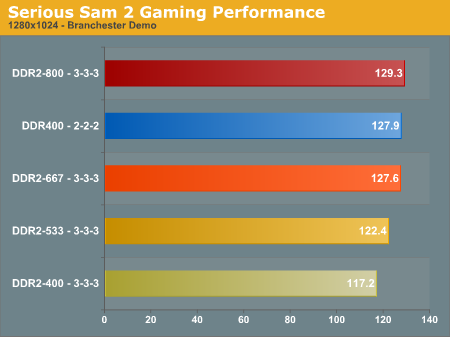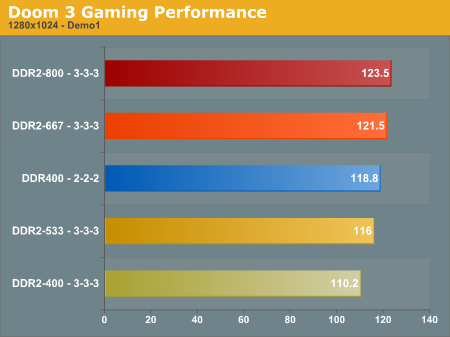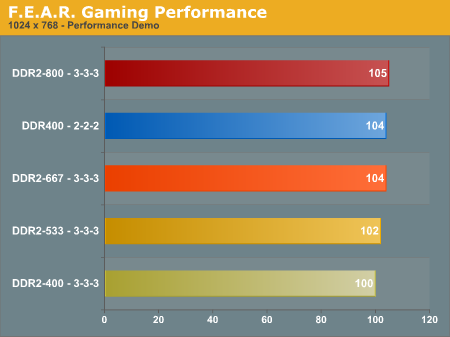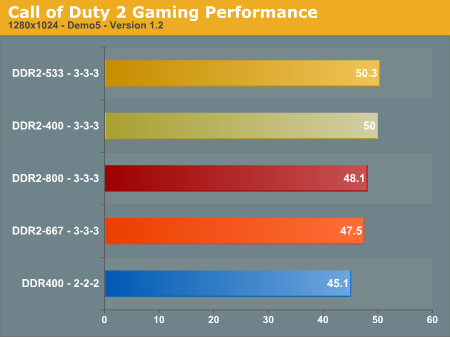First Look: AM2 DDR2 vs. 939 DDR Performance
by Wesley Fink on April 17, 2006 12:05 AM EST- Posted in
- CPUs
Comparing Gaming Performance
Real-world gaming results were then compared in charts at all tested memory speeds. Despite the lower memory bandwidth, DDR400 performs better compared to DDR2-800 than we really expected. This will likely shift to patterns similar to those seen in bandwidth positioning as the AM2 memory controller is further refined and game patches make better use of AM2 capabilities.





With the exception of Call of Duty 2, DDR2-800 takes the top spot, followed closely by DDR-400 and DDR2-667. (The COD2 issue may be related to the latest 1.2 patch with SMP support; we're looking into the matter more.) What is somewhat surprising is how poorly DDR2-400 does on some of the other tests like Far Cry, where even DDR2-533 is 21% faster. Again, this may simply be last-minute timing issues which will be corrected in the near future, but we don't recommend that anyone run with slower than DDR2-533 on AM2.
Real-world gaming results were then compared in charts at all tested memory speeds. Despite the lower memory bandwidth, DDR400 performs better compared to DDR2-800 than we really expected. This will likely shift to patterns similar to those seen in bandwidth positioning as the AM2 memory controller is further refined and game patches make better use of AM2 capabilities.





With the exception of Call of Duty 2, DDR2-800 takes the top spot, followed closely by DDR-400 and DDR2-667. (The COD2 issue may be related to the latest 1.2 patch with SMP support; we're looking into the matter more.) What is somewhat surprising is how poorly DDR2-400 does on some of the other tests like Far Cry, where even DDR2-533 is 21% faster. Again, this may simply be last-minute timing issues which will be corrected in the near future, but we don't recommend that anyone run with slower than DDR2-533 on AM2.










37 Comments
View All Comments
Ecmaster76 - Saturday, April 15, 2006 - link
Wouldn't it be the best way to suck up bandwidth? We already knew a single core had enough bandwidth from the 754-939 transition.I guess its not that big a deal now because the parts aren't even for sale. But as long as you do tsome multitasking articles on the final hardware I'll be happy.
IntelUser2000 - Saturday, April 15, 2006 - link
So... the conclusion is that DDR2-800 is needed to outperform DDR400. DDR2-667 is slower than DDR400. The Inquirer is correct, contrary to some other opinions.Wesley Fink - Saturday, April 15, 2006 - link
Latency and Bandwidth of DDR2-533 are about the same as DDR400, and DDR2-667 and DDR2-800 are both faster. Games and Applications SHOULD be faster on both DDR2-667 and DDR2-800. However, given current aopplications and the AM2 memory controller, the applications and games are about the same at DDR2-667 - and DDR2-800 is faster as you state.This is likely the result of the late pre-release AM2 memory controller and applications/games themselves not being optimized for DDR2 on AM2. Both will likely be fixed very quickly, and actual performance of DDR2-533 should then be roughly on par with DDR400 - with 667 and 800 both faster.
psychobriggsy - Saturday, April 15, 2006 - link
If 2.5GHz was a 40% overclock, then the AM2 processor tested must have been running at 1.8GHz (9x200, i.e., it was also unlocked for you to get 10x250).It's not surprising that a 1.8GHz K8 processor wouldn't benefit from DDR2 much - indeed I expect that most of the application improvements were just from the slightly reduced latency at DDR2-800 rather than actually having more bandwidth available.
I wonder what a stock 2.8GHz AM2 X2 with DDR2-800 would get against a stock 2.8GHz 939 X2 with DDR-400? No, I don't think it will be a miracle, but just possibly it will start actually needing the extra bandwidth available, which could lead to a greater gap between the two platforms.
I guess we'll find out in under 2 months.
Wesley Fink - Saturday, April 15, 2006 - link
The AM2 processor was NOT a 1.8GHz x2. I stated the CPU could overclock 40% at stock speeds, but the 10x250 is not that 40% overclcok. We chose that ratio because it is a clock speed our DDR2 memory could handle and it was also a speed doable on 939 for a reasonable comparison. We actually had two AM2 processors this round, a top-line AM2 and a more mainstream processor. We looked at performance from both, and it was the same at the same processor speed. The DDR2 memory controller reports as Rev. F.As for the question about manufacture date, we are providing as little information about these pre-release processors and motherboards as possible to protect our sources. We have several sources who work with us to bring you the latest news before anyone else, and we don't want to compromise those relationships. Therefore we are not providing any information that might make it easier for AMD and others to trace our sources.
We can assure you these are the latest Rev. AM2 shipped to AMD partners in early April as we have evaluated 4 versions since mid-January. This is also the first rev. to fully support DDR2-800.
Viditor - Saturday, April 15, 2006 - link
Fair enough...had to ask.
Viditor - Saturday, April 15, 2006 - link
My concern is that while Anand is just receiving the part, if it's off of a recent production run then AMD will have some problems with the launch. Usually you need a full turn's worth of product in inventory for a launch...if they are just turning out final product now, then my guess is there will be shortages come July. Of course since they have doubled their capacity recently it will be much less, but still...it doesn't bode well.Anand, could you confirm the manufacture date of the chip you tested for us please?
Viditor - Saturday, April 15, 2006 - link
Apologies...I should have addressed the previous question to Wesley (sorry mate).I know that APM allows AMD to change anything (even down to individual dice on the wafer) at any point in the process, but my concern is inventory levels here. If you could please confirm the production date on the chip you used for testing, it would help me significantly with my analysis of the upcoming launch.
Cheers!
Jynx980 - Saturday, April 15, 2006 - link
Typo on page 3, paragraph 5:Wesley Fink - Saturday, April 15, 2006 - link
The extra "we" has been removed.